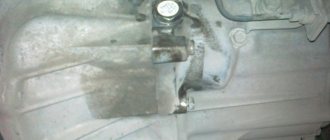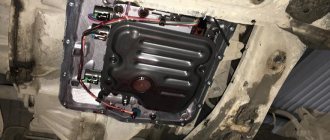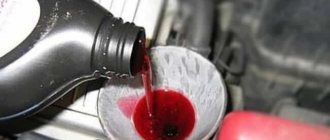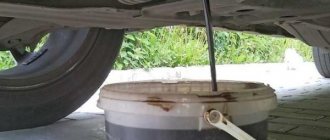Before buying a car, many people try to choose the model that will completely suit them, including its technical characteristics. Some prefer an automatic transmission, some prefer a manual one, despite the high fuel consumption, while others prefer a variator, which combines the advantages of the first two gearboxes. Its advantages include low fuel consumption, lack of jerking when changing gears, and the ability to transmit more torque.
Honda Fit continuously variable transmission
Pros and cons of CVTs
The first CVTs produced were not particularly reliable, but over time the quality of production has greatly improved thanks to the use of modern equipment, technologies and materials. The oil used for such gearboxes has also undergone modernization, which has made it possible to increase their service life. However, there is a minus: it has to be changed somewhat more often than with manual and automatic transmissions, but all this affects comfort and fuel economy.
Modern models of CVTs installed on the Honda Fit have a service life of 200 thousand kilometers without malfunctions, however, such operation of the gearbox is guaranteed by timely oil changes and careful driving. According to the technical documentation of the car, the special fluid in the variator should be replaced every 20-30 thousand kilometers, that is, after one lubricant change in the engine. The downside, of course, is the lack of savings, but the “health” of the Honda Fit depends on timely replacement.
The disadvantage of a CVT transmission is that it is difficult to climb uphill: if you start on an incline of more than 40 degrees, the CVT will skid a lot as the engine speed increases. You should not operate the Honda Fit in this mode for a long time: this may cause the box to burn out. The best option is to carefully go down in reverse onto a flat section of the road and go up the hill with acceleration. In fact, the extra few minutes spent on the road will not play a serious role, but you will have to pay a lot of money to repair the variator.
Recommendations for extending the life of the variator and oil
To avoid putting your car through repairs again, it’s best to follow these tips:
- You should not move away immediately in winter. It is necessary to warm up the car to avoid metal fatigue;
- From time to time it is necessary to inspect the sensors to ensure that they are free of dirt. You should also check their integrity - this way you can avoid false positives;
- if you have problems driving a car, you need to study the error codes issued during diagnostics;
- cleaning the radiator during repair will also increase the service life of the oil;
- you should not resort to partial replacement of the fluid inside the variator - only a complete change will ensure normal operation;
- you cannot drive at high speed for a long time - a regular passenger car is not designed for such loads;
- Constant use of a car with a CVT is also unacceptable for towing other vehicles.
The oil must be stored at a positive temperature, away from sunlight, and work must be carried out only indoors to prevent debris from getting into the liquid. If there is a mileage of more than 60 thousand kilometers, replacing filters is not discussed - the old copy must be removed in favor of a new one, since cleaning is useless.
Old and new oil filters
How to determine the condition of the variator when buying a car
When purchasing a used car, it is advisable to pay attention to the condition of the gearbox, especially if it is a CVT type. A ignited variator can be determined very easily - to do this, fully press the gas pedal and at the same time monitor the behavior of the tachometer needle. When increasing the number of revolutions to 4 thousand and maintaining the vehicle speed to 50 km/h, there is a high probability of wear of the variator discs. During normal operation of the variator, the tachometer needle will rise above 2 thousand revolutions at a speed of 80 km/h; in addition, no jerks or jolts should be detected during engine braking and acceleration. If this happens or the tachometer needle constantly jumps, it is likely that the expansion and compression disks have acquired scratches and burrs to which the belt clings.
Belt replacement
During repairs, as well as when necessary, the owner of a Honda FIT is faced with the problem of replacing the variator belt. This service is very common and does not cause any difficulties for experienced specialists to perform.
The belt must be changed both according to the regulations and when symptoms of a violation of its integrity appear. Cracks, tears, and abrasions ultimately lead to element failure, the consequences of which will take a long and expensive time to eliminate.
During technical manipulations, it is important to ensure cleanliness and order around the box - getting foreign objects inside the box is strictly prohibited. The replacement process involves removing the crankcase and pulleys, which requires tools and devices available to service specialists
The replacement process involves removing the crankcase and pulleys, which requires tools and devices available to service specialists.
Cost of service for replacing the variator belt
You can check the price of the service by phone. Please note that you will also have to purchase the belt itself and some consumables that come with the element.
Checking the oil level in the variator
The quality and duration of operation of any mechanism largely depends not only on the materials of manufacture, but also on the environment in which it operates. To be sure that all components and mechanisms of the Honda Fit variator are working properly, it is enough to regularly check the lubricant level. It is carried out quite simply, the process itself does not take much time.
Replacing lubricant in the variator
What kind of oil to pour into the Honda Fit variator
There are many different types and brands of transmission fluid on the market. In addition, the manufacturer in the instruction book offers certified substances for changing transmissions. The owner himself can choose a different type or brand of oil, but it is advisable to rely on the manufacturer’s values.
The manufacturer suggests using substances with the indices ATF-III or ATF-IV to fill the Honda Fit automatic transmission with oil. In total, there are 3 large groups of transmission oils on the market, which differ not only in composition, but also in their main characteristics:
- Synthetics are produced almost entirely on the basis of special additives and therefore have better cleaning and cooling properties compared to competitors. During operation, the composition covers all mechanical parts of the automatic transmission with a thick layer of film, creating a protective effect during friction and, accordingly, increasing operating efficiency. Such products are superior in cost to direct competitors, but when used in a variator they are best suited.
- Semi-synthetic. In the manufacture of this type of product, various additives are used, but in smaller quantities. Its characteristics are inferior to pure synthetics, but it has less fluidity, which has a beneficial effect when used at constant sub-zero temperatures. This product is also used when used on units with high mileage, since over time various leaks and crankcase fogging occur, which cause a decrease in the overall oil level in the box.
- Minerals are the least popular due to their mediocre characteristics. Such substances do not have high cleaning properties in relation to a modern unit, such as the Fit variator. An exception may be cases where the unit is used in extreme natural conditions in order to avoid squeezing out the substance through the breathers and seals of the box.
Read more: Car charging circuit for a phone
Signs of a high oil level in the variator
You can often encounter a situation where the oil level in the Honda Fit transmission is too high. This is diagnosed by the following signs:
- It's hard to change gears;
- In the neutral position of the variator, the car continues to move forward;
- Third-party problems may arise in the operation of the variator.
When checking the lubricant level in the Honda Fit variator, you must carefully ensure that no debris or foreign particles get on the dipstick or its tube.
Check the fluid level in the Honda Fit variator as follows:
- The car is driven onto a horizontal, flat surface.
- The engine is started and left to run until the cooling system comes on. The fan should not be allowed to start again - in this case, when checking, the level will be higher than it actually is.
- It is advisable to measure the level within 60-90 seconds so that the lubricant does not cool down and its volume does not decrease.
- The dipstick for measuring the level is removed and, after cleaning, again immersed in the hole.
- A mark should appear on the re-pulled dipstick indicating the separation of the dry part and the wetted part. The best option is that the boundary should pass between marks A and B on the probe. If the limit is above mark A, then it is advisable to drain the excess liquid, but if it is below mark B, then it is topped up to the required level.
Checking the lubricant level
How to Check the CVT on a Honda Fit
How to change the oil in a Honda Fit CVT?
Some motorists today consider CVT gearboxes to be insufficiently reliable, but this is a mistaken opinion. If you change the oil in the Honda Fit variator in a timely and correct manner, this unit will serve for many years without a single breakdown.
Frequency of oil change in the variator
The Honda Fit car manufacturer recommends changing the oil in the variator every 45 thousand kilometers, but we recommend doing this more often. In our country, cars are operated in rather harsh conditions, so it is better to reduce the time frame for replacing all fluids in systems by about one and a half times.
Some order the service of changing the oil in the Honda Fit variator at specialized service centers, but we will tell you how to do it yourself at home. The procedure does not take much time, but it saves a certain amount of money.
What oil should I use and how much will I need?
The automaker and experienced technicians advise using only original CVT-F and HMMF oils, which are affordable, so there is no point in trying to find analogues. Under no circumstances should you fill CVT gearboxes with lubricants intended for classic transmissions, as lubricants differ in characteristics. If you make a mistake and fill the variator with regular gearbox oil, the transmission will fail within 1-2 weeks or even earlier.
To change the oil in Honda Fit variator you will need a little more than 3 liters of lubricant, and for the second generation exactly 3 liters will be enough.
System oil level
There are certain signs by which you can diagnose excess or lack of oil in the CVT gearbox installed on the Honda Fit.
Symptoms of lack of oil in the variator
The main symptoms by which you can determine insufficient oil level in the Honda Fit variator include the following:
- Engine vibrations when idling.
- The car jerks when starting to move forward or backward.
- The car accelerates more slowly than initially.
- The car does not move.
Signs of Excess Oil
find out that the oil level in a car’s variator is too high by the following symptoms:
- Difficulty changing gears with a variator.
- When the switch is in neutral, the car moves forward slowly.
- Sometimes exceeding the oil level in the variator leads to serious problems in the system, which only an experienced auto mechanic can diagnose.
THIS IS INTERESTING: Where do the wipers turn on in a car?
Honda fit variator operation
I'll tell you how to repair a variator
in 1.5_2.hours, completely eliminating vibration, kicks, shutdowns, etc.
The variator was kicking, vibrating, brrr, I found a reason WATCH TO THE END
CVT calibration
Honda
fit
, adjusting starter clutch pack.
Variator
swra.
Checking the oil level
To check the oil level in the Honda Fit CVT gearbox, you must follow the following instructions:
- Park the machine on a level surface.
- Start the engine and wait until the cooling fan comes on (the engine is completely warm), and then turn off the car.
- It is important to prevent the fan from turning on again when warming up, otherwise during the check you will find that the oil level in the variator is higher than the actual data. Also, if you do not immediately measure the level, but wait 1-2 minutes, the oil will cool down and its actual volume will be underestimated.
- Remove the dipstick used to determine the oil level in the variator (it has a yellow ring-shaped handle) and wipe it with a napkin, and then put it back in place.
- Pull the dipstick out again and look at the oil level on it. The boundary must be between the two minimum and maximum level marks. If the oil level exceeds the maximum mark, the excess liquid should be drained, and if the level is below the minimum mark, the lubricant must be added to the required level.
Tools for changing oil in a Honda Fit variator
To do this job, you will need a simple set of tools that should be in every motorist's garage. These include the following:
Replacement instructions
When changing the oil in the Honda Fit variator, you must be careful and ensure that no dirt or grains of sand get into the box or on the dipstick. Otherwise, they will penetrate the system and act on the rubbing parts, like sandpaper, gradually disabling them. You need to proceed according to the following instructions:
- Before work, warm up the engine until the cooling fan turns on, and then drive the machine onto a lift, overpass or pit. You can also simply lift the car using a jack. Reach under the bottom and unscrew the engine protection.
- Under the hood, find the dipstick for measuring the oil level in the variator and remove it from the neck by pulling the yellow ring.
- Go back under the car again, find the drain plug at the bottom of the transmission housing, and place a container under it to drain the old lubricant.
- Using a square wrench, unscrew the plug from the variator housing.
- Wait until the lubricant drains completely. The process usually takes 20 to 30 minutes. Be patient to allow all the oil to drain from the system.
- The CVT drain plug has a special magnet that attracts small metal particles that enter the crankcase. Therefore, the cork must be thoroughly cleaned of all this debris.
- Wipe the cork several times with a clean rag to remove any shavings. Feel free to discard the old rubber seal ring for the plug (it is disposable). Install in its place a new one, purchased along with the oil in the store.
- Make sure that all the oil from the system is clear, and then tighten the plug and reinstall the crankcase protection.
- Prepare a new lubricant, which is better to pour from the canister into a more convenient container or use a funnel.
- You can compare the old oil with the new one - you will definitely notice the difference.
- Insert the hose into the filler neck, attaching a funnel to it if you have one.
- Fill in about 3 liters of new oil, and then check the level using the dipstick.
The process of changing the oil in the Honda Fit variator is complete, and you can start the car and drive out on the road.
Source: https://top-geer.ru/kak-proverit-variator-na-honde-fit/
Which oil is suitable for the Honda Fit CVT?
For the first generation Honda Fit continuously variable transmission, they mainly use only original oils - HMMF or CVTF, which are the same HMMF, only produced for the American and European markets. It is better not to use other special fluids for CVTs.
Special fluid HMMF
HMMF special fluids (CVTF) were created by Honda, and there are no other analogues of these oils. Only Honda has production rights; they have not been transferred to any other company, therefore for CVTs of cars of this brand it is necessary to use only original special fluids.
The composition of HMMF (CVTF) includes not only cooling additives, but also special materials, thanks to which the balance of fluid parameters is maintained. In fact, the same liquid can simultaneously remove heat, lubricate rubbing parts, and increase friction between the pulley and the belt so that one does not slip into the other.
How to properly maintain a variator
Similar articles
- Honda regulations
- How to properly flush the engine
- Honda models
So, for Honda CVT * only oils from Honda are used called HMMF (Honda Multi Matic Fluid) or CVTF (the same HMMF, but for the European and American markets). No other oil, no matter how wonderful its name, is suitable for CVT Honda!
Left: HMMF (Japanese Domestic Market). Right: CVTF (American market).
There is no “complete replacement” or “complete analogue” of HMMF special fluid other than Honda CVTF special fluid. Honda did not transfer production rights to any company, neither Castrol, nor Mobil, nor Yokki. The can of these fluids may say that they “meet Honda requirements,” but they do not have a RECOMMENDATION for use in Honda components.
Please pay special attention to this as the HMMF (CVTF) has been specifically designed for the unique Honda Multi Matic (HMM) system with the already mentioned friction discs. The history of the origin of HMMF is not a secret - it is a continuation of the development of ATF Z1, which, as we already know, is the successor to the “classic” Dexron II. On early Honda CVTs (Civic cars in the EK3, HR-V, Integra SJ body), ATF Z1 is even written on the gearbox dipsticks, but this mark is the same story as with the Dexron II inscription on automatic transmissions before 1996. The use of ATF Z1 is permissible on CVTs before 2000, but for a short time. On later cars, driving on ATF Z1 is generally unacceptable.
The reason for this limitation lies in the chemical properties of HMMF (CVTF) and the fundamental difference between the Honda CVT and all other similar designs. We have already talked about the feature of HMM, but what is so special about HMMF (CVTF)?
The fact is that the unique composition of HMMF (CVTF) contains, in addition to a package of cooling additives, a special material that allows the fluid to balance in a working variator between lubricating and friction-increasing parameters! That is, the same liquid must simultaneously act as a heat sink, lubricant, and friction amplifier between the belt and pulley to avoid slippage. Other liquids are simply not capable of this!
Now about the replacement period. It should be remembered that aging of HMMF fluid leads to a decrease in its ability, which ultimately leads to belt slippage, and so on. Only fresh fluid can maintain all the necessary parameters at normal levels, so under no circumstances should you delay replacing it.
Determining the aging of HMMF (CVTF) “by eye” is also unrealistic, as in the case of ATF Z1. If the “master” says that the liquid is still clean and transparent and does not need to be replaced, then he is not a professional. Only an expensive analysis using special equipment, the cost of which can exceed all reasonable limits, can tell you about the quality of the liquid. If you doubt the quality of the fluid poured into your Honda's variator, it is better, easier and cheaper to change it.
Large variable speed filter installed under the pan.
To replace HMMF you will only need about five liters of fluid, and not twelve, as they call it at some service stations. In principle, flushing is not even contraindicated for the first Honda CVTs, since when replacing the fluid it is necessary to change two filters installed in the box - one in the sump (HR-V) or near the radiator (Civic EU, the second on the CVT body itself. But flushing is better do not use - partial replacement even in this case will be more correct.Also, you may need a variator pan gasket, although it is made of cardboard.
The process of replacing special fluid in Honda CVTs with a sump is described in detail here .
On later CVTs (Fit), there is no pan, and the replacement process is reduced to a partial oil change, as is the case with a conventional automatic transmission. Some models may have an additional remote filter, similar to the one found on the Civic, or, conversely, located in the box housing.
In all cases, the amount of oil drained and filled will be approximately the same - from 3.8 (FIT) to 4.6 liters (HR-V). It is always better to take a little more oil, since having it is always more convenient than not having it. If a standard Japanese can of HMMF is enough for the Honda Fit, then for all other CVTs you will have to look for another additional liter. Although it won't be superfluous. Many people forget, for example, that when removing drives to replace boots, a small amount of oil is drained, which must be restored after the operation is completed. That's when the remaining oil will come in handy.
To replace 85-90% of the fluid in a heavily worn variator, you, as in the case of an automatic transmission, will have to repeat the oil change operation after 200-300 km, however, most often this is not required. After the first replacement, it becomes clear whether the variator is alive, or whether all procedures are already too late.
If, nevertheless, the CVT cannot be helped by replacing the fluid, all that remains is to repair it, and here one can only sympathize with the owner of the variator. The problem is that spare parts for the CVT unit are not available for sale in any form other than the assembled unit. In terms of cost, the unit is sometimes more expensive than the cost of the entire car if it was bought secondhand. There are precedents when it was possible to find the actual belt, with the replacement of which all problems disappear, but this exception, one might say, was just lucky.
So Russian masters are absolutely right when they say that the variator, in the event of a breakdown, is absolutely beyond repair. There are simply no spare parts for it. Many, if faced with such a problem, tend to replace the entire box with a contract one, i.e. used. Unfortunately, unlike a conventional automatic transmission, where replacement is acceptable because its service life is much longer, in the case of a CVT it turns out to be a real lottery. There is a chance of winning, but in this case you will simply receive a working car, which is what you actually paid money for. A loss will mean a definite loss of funds - one installation of a checkpoint costs a lot of money, and after a month the slippage will begin again.
It’s also worth mentioning which brands of Honda have a CVT. Often, although not always, it is found on Civics in the EK3, EU1, ES1 body, on all HR-Vs, except with manual transmission, on almost all Fit (Jazz).
There are particularly interesting solutions that are truly exclusive. The court "tuning studio" of Honda, with modifications to the Honda Fit. So among its products there is a unique Fit Mugen, with a turbocharged (!!) L15A engine and all on the same CVT. Let's hope that the life of the variator on this “bullet” will be as long as it looks impressive, and “shoots” even more impressively!
In general, any car after 1998 with an engine capacity of up to 1600 cc may well have a CVT on board. On cars with large volumes, CVTs are not installed for the same reason - the complexity of combination and unreliability of the unit. However, technology does not stand still. An exception to this rule is the Honda Odyssey - a minivan with an engine capacity of 2400 cc, in the RB1 body, except for the Absolute (and also M) configuration. On these large cars with a powerful engine, in addition to the above-mentioned equipment, there is a CVT gearbox.
Summing up the conversation about the variator, it is necessary to emphasize the following - the variator gearbox is a reliable, promising unit that still requires some care and attention. Fluid replacement, always with filters (if available), should be done regularly, every 35,000 - 40,000 km. If filters are not available, a partial replacement is performed, as is the case with a conventional automatic transmission. If you have a CVT, sudden acceleration, braking, and long-term travel at speeds of more than 120 km/h are strictly not recommended.
*Second-generation Honda CVTs include transmissions installed on Honda Accord (variables since 2013) and Honda Fit (variables since 2015). In this case, another technical fluid is used - HCF-2.
To determine the required type of fluid used in the automatic transmission of your car, we recommend that you carefully study the vehicle’s operating instructions before repair work.
Hondavodam.ru
If you find an error, please select a piece of text and press Ctrl+Enter.
More interesting articles
Oil change timing
The parameters and capabilities of the special fluid for Honda begin to “age” over time, which as a result can cause belt slippage and other problems. The characteristics necessary for normal operation of the variator are maintained only by fresh fluid, so it is necessary to replace it regularly.
The “aging” of the fluid used in Honda Fit CVTs cannot be determined by eye - this can only be done through analysis using special equipment. If the quality of the filled liquid is in doubt, it is best to simply change it.
A complete oil change requires about 5 liters of lubricant. In addition, with each fluid change, it is advisable to change the filters located in the gearbox - one is located near the radiator or in the sump, the second is on the body of the variator itself. However, it is still better not to use flushing - the benefits of a partial replacement will be greater. In addition, you may need to replace the pan gasket, but later models of CVTs are produced without it, and the oil in them is changed in the same way as an automatic transmission. Some models have a remote filter - a similar one is installed on Civic cars.
How much oil do you need to fill in a Honda Fit automatic transmission?
First generation GD, 2001-2007
Compact dimensions and a roomy interior were the key advantages of the first-generation Fita, which had a simple and uncomplicated design: due to the high roof and short hood, the car resembled a compact van rather than a stylish European hatchback. Nevertheless, Fit was in steady demand primarily among family buyers. The popularity of the model turned out to be so high that a four-door sedan Fit Aria was created based on the hatchback. In Japan, the Fit was offered with 1.3 and 1.5 liter gasoline engines (86-110 hp), which were combined with a manual transmission or a CVT. The drive could be front-wheel drive or all-wheel drive, and in Europe only FWD versions were offered. The Fit appeared on the American market in 2006 and was available only with a 1.5 liter engine, as well as manual or automatic transmission.
Also read: Automatic transmission oil for Mercedes W211
Automatic transmission oil: volume – 5 liters with a complete change; 2.5 liters with partial replacement
Second generation GE, 2007-2013
The design of the second generation Fit featured a new corporate style, relevant to the Honda lineup of that time. In general, the car has become more streamlined thanks to its aerodynamic shape, as well as the covered windshield. At the same time, the hood remained short, which is why the Fit was still perceived as a family compact van with large headlights. However, car experts noted an improvement in handling, and in general, driving performance was no worse than its European counterparts, and the level of equipment became noticeably higher. At the same time, the quality of materials has improved and new equipment has appeared. The engine range, consisting of the previous 1.3 and 1.5 liter engines, was thoroughly modernized: in addition to the appearance of the i-VTEC system, the engines developed from 100 to 120 hp. With. and worked with a manual, automatic or continuously variable transmission. As before, in Japan the car had all-wheel drive, and the basic versions had front-wheel drive. In the USA, top versions of the Fit were offered with a 1.5 engine and an automatic transmission, which would later be replaced by a CVT (since 2013).
Automatic transmission oil: volume – 5 liters with a complete change; 2.5 liters with partial replacement
Possible problems with the variator
When changing the oil, the amount of fluid filled and drained will always be approximately the same - from 3.8 to 4.6 liters. It is better to purchase a little more liquid than you need - let it remain in stock. For example, a Honda Fit requires one HMMF tank, while other models will require two tanks.
If the level of wear of the variator is too high, then replacement is carried out literally after 200-300 kilometers, but in most cases such expenses are not required. As a rule, one replacement is enough to determine whether the gearbox is working or can be thrown away.
If replacing the fluid does not affect the situation in any way, then only repairs remain. And here the worst thing begins: spare parts for the variator on the Honda Fit are almost impossible to find. Only complete units are available for sale and it is extremely rare to find a separate belt, the repair of which can solve most problems with the gearbox.
The CVT gearbox, in fact, is absolutely not suitable for repair, so in case of breakdowns it is advised to completely change it, rather than look for parts and spare parts. Often in such situations, they try to replace a failed box with a contract one, that is, one that has already been used. This solution turns out to be advantageous in the case of a conventional automatic transmission, but is not entirely suitable for a CVT. Most likely, after such a replacement, the breakdowns will return after a month or two of normal driving on an initially serviceable car.
In fact, a CVT gearbox is a good component of a car, characterized by high quality and reliability, but it requires care and timely maintenance. Change oil and filters every 35-40 thousand kilometers. If it is not possible to replace the filters, then carry out a partial replacement of the fluid by analogy with an automatic transmission.
The Honda Fit variator is a very capricious “car of the future”, which requires special care and operation and does not tolerate sudden braking, acceleration and prolonged movement at speeds over 120 km/h.
Information on changing the oil in a continuously variable transmission
Introduction
Honda has developed a high-tech variator for the compact van of the same name, which is capable of saving fuel, and gear shifting is almost imperceptible. However, over time, even such a gearbox tends to wear out, like any other mechanism. Transmission oil is designed to maintain its reliability. It is advisable to use only high-quality liquid from a reputable manufacturer. And if possible, fill in the original lubricant. Of course, this is also not enough for reliable and efficient operation of the transmission. After all, in addition to this, it is also necessary to change the fluid in a timely manner.
The most popular articles on the site:
- How often should you change engine oil?
- Oil 5w30 and 5w40 what is the difference
- What oil to pour into the engine in winter and summer
- How long does it take to change the automatic transmission oil?











